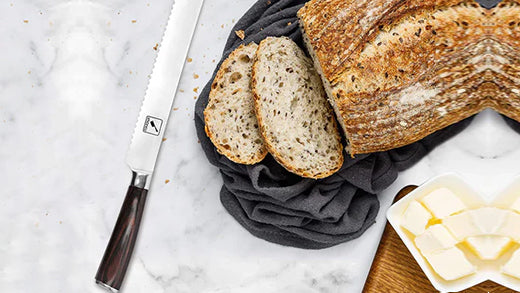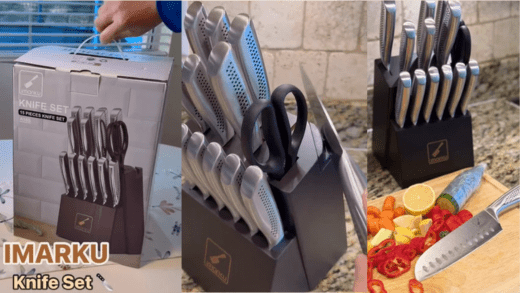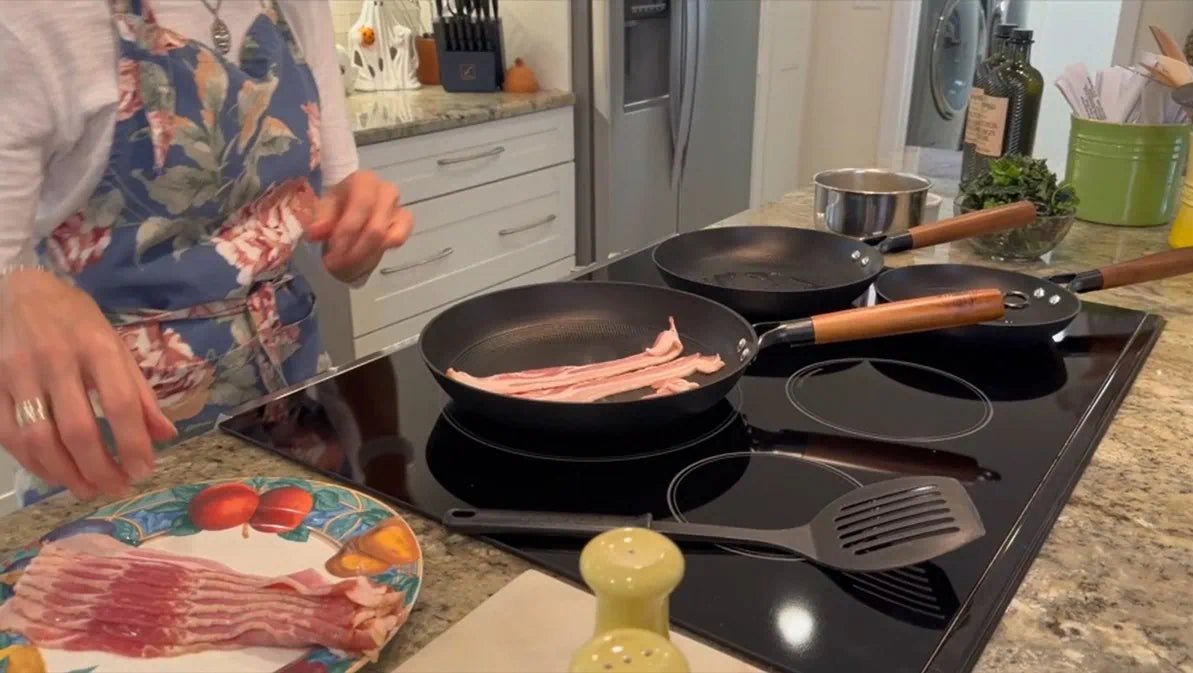TABLE OF CONTENTS
Serrated knives are the unsung heroes of the kitchen, offering unparalleled precision when it comes to slicing through crusty bread, ripe tomatoes, and even succulent steaks.
But to keep these culinary tools at their peak performance, a well-maintained edge is crucial. This guide is dedicated to all the knife hunters out there looking to preserve the razor-sharp quality of their serrated blades.
Are you interested in learning how to sharpen serrated knives? In this guide, we'll explore how to sharpen a knife, some common mistakes to avoid, and what are the sharpest, highest quality knives on the market.

The Importance of a Sharp Serrated Edge
A sharp knife is a chef's best friend. It glides through food with minimal effort and makes kitchen tasks safer and more enjoyable. Dull knives, on the other hand, can slip and increase the risk of accidents. Regular sharpening ensures that your serrated knives will cut efficiently and safely every time.
Understanding Your Serrated Knives
Before diving into sharpening, let's explore the types of serrated knives and their unique characteristics:
Bread knives: With long, scalloped edges, these knives make slicing bread a breeze without crushing the loaf.
Tomato knives: Their short, sharp serrations are perfect for piercing tomato skin without damaging the delicate flesh.
Utility knives: These all-rounders are great for foods with tougher exteriors, like citrus fruits or sausages.
Steak knives: Designed to cut through meat with ease, these knives often feature serrations for a clean slice.
Each knife is crafted with specific serration patterns and made from materials like high-carbon stainless steel to handle different cutting tasks.
3 Ways to Sharpen Your Serrated Blades
Sharpening serrated knives is different from sharpening straight-edged blades. Here's how to keep them sharp:
Sharpening stones: These are great for honing the individual serrations on your knife.
Honing rods: A rod can fit into the serrations, realigning and sharpening each tooth.
Electric sharpeners: Some models have settings designed for serrated knives, offering a quick and easy sharpening solution.
How to Sharpen Serrated Knives Step by Step
To sharpen knives safely, start with a tidy workspace. Lay knives on a towel or cutting board for convenience. Keep veggies or bread nearby for post-sharpening checks.
Ensure safety by clamping the knife in a vice grip to prevent slipping. Have a first aid kit on hand for precaution. For larger blades, get assistance to steady the knife and reduce the risk of damage.
1. Choose the right equipment
To sharpen serrated knives, first identify the serration width to select the correct sharpening rod size. While one rod may suffice for most knives, varying gullet sizes could necessitate multiple rods. Avoid using flat files or edge sharpeners; instead, consider a V-shape sharpener with rods for a variety of knives./p>
2. Find the beveled edge
Identify the beveled edge of your serrated knife, which is the side with prominent serrations appearing like small scallops. Only this side should be sharpened, as sharpening the flat side can damage the knife. Once the beveled edge is identified, you can start sharpening with the sharpening iron.
3. Determine the correct angle to sharpen
Start your serrated knife sharpening process by examining the knife's scalloped edge to determine the size of the serrations, or 'gullets'. This will guide the size of the sharpening rod you need. Most serrated knives will require just one standard rod.
Avoid using flat files or edge sharpeners as they are ineffective for serrated knives. Instead, consider investing in a V-shape knife sharpener with rods attached to a wooden base, suitable for a wide range of knives.
If the knife is non-serrated, the rolling knife sharpener could be your choice. You don't need to manually set the sharpening angle, as it has 4 preset angles that meet almost all types of knife sharpening, especially friendly and suitable for non-professional knife sharpeners and beginners.
4. Change tools for different sized gullets or straight edges
Serrated knives, known for their cutting prowess, feature various types and sizes of serrations, often paired with flat edges on the same blade. The serration size may require adjusting your sharpening rod's diameter.
Straight-edged knives, typically found in steak knives, can be honed using a rod or a flat-edge sharpener. If you're uncertain about sharpening your specific knife, consult a knife expert. They can either sharpen it for you or provide guidance before you attempt it yourself. Remember the adage: measure twice, cut once.
5. File away any burrs and test
During sharpening, burrs or tiny metal wisps on the blade's back signal metal removal. Regular checks for excessive burrs can prevent blade weakening. After achieving sharpness, remove burrs with a file for a polished finish. Test sharpness on food. If unsatisfactory, clean and repeat the process. Slow, careful sharpening is advised to avoid damage.
3 Common Mistakes to Avoid When Sharpening a Serrated Knife
Sharpening serrated knives requires practice. Start with an old knife to avoid damaging a valuable one. Over-sharpening can create stress points, potentially breaking the blade and ruining its appearance. To prevent harm to your knife and yourself, steer clear of these three common beginner errors.
Secure Your Knife
To avoid the knife or iron slipping during sharpening, which can lead to accidents, it's essential to secure the knife in a vice grip or place your iron into a sharpening apparatus. If sharpening by hand, ensure a stable workspace to anchor your tools.
Avoid Dishwasher Damage to Knives
Hand-washing is crucial for maintaining the sharpness and integrity of your serrated knives. Placing them in the dishwasher can lead to gradual dulling of the serrations and potential damage to the knife's edge.
Additionally, the dishwasher's moisture and heat can harm organic handle materials, such as wood, leading to cracks. To preserve your knife's condition, always hand-rinse and avoid using the dishwasher.
Avoid Over-Sharpening
Regularly check your progress to prevent excessive metal removal. Once too much metal is filed off, it cannot be replaced. Metal is forgiving up to a point, but using a diamond file can accelerate metal removal more than expected.
Frequently pause to feel for burrs on the non-beveled side of the blade, which indicate how much metal you've removed. Also, test the knife's sharpness often to determine when to stop filing. Over-sharpening can reduce the knife's longevity and the number of times it can be re-sharpened before it becomes unusable.

Frequently Asked Questions
How Do I Store My Serrated Knife?
Storing your knife properly is half the battle when it comes to sharpening a serrated knife. Knife blocks are a standard kitchen counter resident but aren't exactly ideal.
The wood can lock in moisture, and standing the knives vertically in a box can cause damage (if they even fit, to begin with).
Some professional chefs have heavy-duty bags made to store their knives safely. But if you want the easiest (and most ideal) way to store your knives, get a magnetic strip. It keeps the knives safe against the wall, secured by the non-beveled side.
Can all serrated knives be sharpened?
Yes, most serrated knives can be sharpened, but there are some exceptions. Single serrated knives, typically used for bread and tomatoes, can be sharpened. However, knives with micro serrations or double serrations are not designed to be sharpened.
How often should you sharpen serrated knives?
Serrated knives require less frequent sharpening than straight-edge knives due to their construction and usage. They can maintain their cutting efficiency for years. However, if you notice a decline in performance, it's time to sharpen.
Generally, knives should be sharpened once or twice a year, but the exact frequency depends on usage and the materials cut.
How to determine if a serrated knife needs sharpening?
When a serrated knife starts becoming dull, it'll require more downward pressure and movement to get the job done. You'll notice way more crumbs than there usually should be when cutting bread, for example. The knife might even slip off the bread altogether. These are signs that your serrated knife needs some attention.
Can I Pay an Expert to Sharpen My Knife?
When in doubt, contact the experts. The experts, in this case, are your average metal working tradesmen who have grindstones and more specialized equipment.
If you're nervous about sharpening a serrated blade, you can rely on them to have all the proper-sized rods and tools. They frequently sharpen knives for restaurants and kitchens, and it's usually relatively low cost as well.
If you've attempted to sharpen your knife on your own and it's damaged beyond all repair, consider taking it to a smith. They might be able to save it, which is helpful considering how expensive knives are.
If it's beyond repair, perhaps they could remove the serrations to make a flat edge or create new serrations altogether.

How Do I Avoid Injuring Myself During Sharpening?
To avoid injuring yourself, move slowly and methodically. Work in a well-lit environment. If you're working with a smaller knife, you might consider investing in a magnifying lens or light. Leather or chain mail gloves make it more difficult to maneuver the knife, but help tremendously when it comes to safety.
You might be sure you won't lose a finger while sharpening. Still, most injuries are cuts and gashes that can easily be infected. Always have a first aid kit nearby that includes gauze.
When to Choose Serrated vs Non-Serrated
Serrated knives, often underrated, are engineered for clean, precise cuts, especially through tough exteriors and soft interiors like bread, tomatoes, and meats.
Despite the allure of straight-edged blades, they can't match the performance of serrated knives on such tasks. Some serrated knives feature a half flat-edged design, offering versatility, with the straight edge providing delicate cuts and the serrated edge handling tougher areas.
Learn more details about serrated vs non-serrated blade.
Conclusion
Sharpening serrated knives requires patience and caution. These tools are a blend of utility and ancient art. Trust your instincts to refine the blade, and don't fret over mistakes—metalsmiths can fix minor issues.
Many avoid sharpening serrated knives due to perceived complexity, but it's straightforward: follow the existing grooves to revive the knife. The satisfaction of testing a successfully sharpened knife is immense, fostering a sense of accomplishment and independence.






















Leave a comment
All comments are moderated before being published.
This site is protected by hCaptcha and the hCaptcha Privacy Policy and Terms of Service apply.